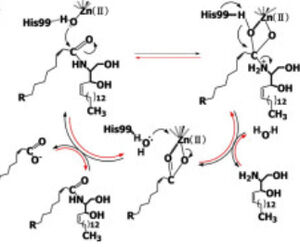Ceramidase
From Proteopedia
(Difference between revisions)
| Line 18: | Line 18: | ||
== Role of Ceramide and CerN in Bacterial Infections == | == Role of Ceramide and CerN in Bacterial Infections == | ||
| - | Sphingolipids play key role in eukaryotic cell membrane structure and function.<ref name="Complex">PMID:15289826</ref><ref name="Principles">PMID:18216770</ref> Additionally, sphingolipids act as signaling molecules for eukaryotic processes such as proliferation, apoptosis, inflammation, cell migration, and pathogen defense.<ref name="Principles">PMID:18216770</ref> Ceramide is considered as the central molecule in sphingolipid metabolism, as it can be converted to more complex sphingolipids or be broken down for the production of sphingosine and sphingosine-1-phosphate (Seitz and Gulbins).<ref name="Gulbins">PMID:34064516</ref><ref name="Seitz"><ref name="man">PMID:29863195</ref> Eukaryotes utilize ceramide in the formation of [https://en.wikipedia.org/wiki/Lipid_raft/ lipid rafts], lipid-protein platforms that alter the biophysical properties of cell membranes as well as localize receptors for signal amplification.<ref name="Principles"><ref name="Seitz"> | + | Sphingolipids play key role in eukaryotic cell membrane structure and function.<ref name="Complex">PMID:15289826</ref><ref name="Principles">PMID:18216770</ref> Additionally, sphingolipids act as signaling molecules for eukaryotic processes such as proliferation, apoptosis, inflammation, cell migration, and pathogen defense.<ref name="Principles">PMID:18216770</ref> Ceramide is considered as the central molecule in sphingolipid metabolism, as it can be converted to more complex sphingolipids or be broken down for the production of sphingosine and sphingosine-1-phosphate (Seitz and Gulbins).<ref name="Gulbins">PMID:34064516</ref><ref name="Seitz"><ref name="man">PMID:29863195</ref> Eukaryotes utilize ceramide in the formation of [https://en.wikipedia.org/wiki/Lipid_raft/ lipid rafts], lipid-protein platforms that alter the biophysical properties of cell membranes as well as localize receptors for signal amplification.<ref name="Principles"><ref name="Seitz"> Sphingosine and sphingosine-1-phosphate, the products of ceramide catabolism, are important for pathogen defense by functioning as a potent anti-microbial and activating signal for host-immune responses, respectively.<ref name="Gulbins"> |
| + | |||
| + | |||
Due to its abundance in eukaryotic cell membranes and role in pathogen defense, pathogens have evolved mechanisms to use host ceramides for their own pathogenesis.<ref name="Seitz">PMID:25720061</ref> Ceramide-rich membrane platforms on human-epithelial cells serve as sites for the attachment and invasion of bacterial pathogens such as ''Neisseria gonorrhoeae''.<ref name="Seitz">PMID:25720061</ref> ''Pseudomonas aeruginosa'' is capable of detecting host-derived sphingosine, resulting in activation of ''P. aeruginosa'' sphingosine-responsive genes. The products of ''P. aeruginosa'' sphingosine-responsive genes are used for the detoxification of sphingosine, as well as its production from other host-derived sphingolipids, making ''P. aeruginosa'' sphingosine tolerant. Loss of ''P. aeruginosa'' sphingosine-responsive genes results in the inability of the bacteria to survive in the presence of sphingosine ''in vitro'' or in the murine lung. CerN is one of the proteins encoded by ''P. aeruginosa'' sphingosine-responsive genes used for the production of sphingosine from ceramide, with the added ability of functioning as a ceramide synthase.<ref name="Okino">PMID:9603946</ref><ref name="Reverse">PMID:10832092</ref> It has been hypothesized that the hydrolysis of host-membrane ceramide via CerN facilitates ''P. aeruginosa'' intracellular invasion, similar to other bacterial pathogens. CerN is also involved in ''P. aeruginosa'' [https://en.wikipedia.org/wiki/Biofilm/ biofilm] production, a major virulence trait of the pathogen. Sphingosine production via CerN-mediated hydrolysis of host ceramide induces a biofilm formation at sites of infection, biofilm accumulation yields more ceramide hydrolysis, creating a positive-feedback loop for ''P. aeruginosa'' virulence. | Due to its abundance in eukaryotic cell membranes and role in pathogen defense, pathogens have evolved mechanisms to use host ceramides for their own pathogenesis.<ref name="Seitz">PMID:25720061</ref> Ceramide-rich membrane platforms on human-epithelial cells serve as sites for the attachment and invasion of bacterial pathogens such as ''Neisseria gonorrhoeae''.<ref name="Seitz">PMID:25720061</ref> ''Pseudomonas aeruginosa'' is capable of detecting host-derived sphingosine, resulting in activation of ''P. aeruginosa'' sphingosine-responsive genes. The products of ''P. aeruginosa'' sphingosine-responsive genes are used for the detoxification of sphingosine, as well as its production from other host-derived sphingolipids, making ''P. aeruginosa'' sphingosine tolerant. Loss of ''P. aeruginosa'' sphingosine-responsive genes results in the inability of the bacteria to survive in the presence of sphingosine ''in vitro'' or in the murine lung. CerN is one of the proteins encoded by ''P. aeruginosa'' sphingosine-responsive genes used for the production of sphingosine from ceramide, with the added ability of functioning as a ceramide synthase.<ref name="Okino">PMID:9603946</ref><ref name="Reverse">PMID:10832092</ref> It has been hypothesized that the hydrolysis of host-membrane ceramide via CerN facilitates ''P. aeruginosa'' intracellular invasion, similar to other bacterial pathogens. CerN is also involved in ''P. aeruginosa'' [https://en.wikipedia.org/wiki/Biofilm/ biofilm] production, a major virulence trait of the pathogen. Sphingosine production via CerN-mediated hydrolysis of host ceramide induces a biofilm formation at sites of infection, biofilm accumulation yields more ceramide hydrolysis, creating a positive-feedback loop for ''P. aeruginosa'' virulence. | ||
Revision as of 17:47, 1 May 2022
| |||||||||||
References
- ↑ 1.00 1.01 1.02 1.03 1.04 1.05 1.06 1.07 1.08 1.09 1.10 1.11 1.12 1.13 1.14 1.15 1.16 1.17 Inoue T, Okino N, Kakuta Y, Hijikata A, Okano H, Goda HM, Tani M, Sueyoshi N, Kambayashi K, Matsumura H, Kai Y, Ito M. Mechanistic insights into the hydrolysis and synthesis of ceramide by neutral ceramidase. J Biol Chem. 2009 Apr 3;284(14):9566-77. Epub 2008 Dec 16. PMID:19088069 doi:10.1074/jbc.M808232200
- ↑ 2.0 2.1 2.2 2.3 Okino N, Tani M, Imayama S, Ito M. Purification and characterization of a novel ceramidase from Pseudomonas aeruginosa. J Biol Chem. 1998 Jun 5;273(23):14368-73. PMID:9603946
- ↑ 3.0 3.1 3.2 Kita K, Okino N, Ito M. Reverse hydrolysis reaction of a recombinant alkaline ceramidase of Pseudomonas aeruginosa. Biochim Biophys Acta. 2000 May 31;1485(2-3):111-20. doi:, 10.1016/s1388-1981(00)00029-9. PMID:10832092 doi:http://dx.doi.org/10.1016/s1388-1981(00)00029-9
- ↑ 4.0 4.1 Futerman AH, Hannun YA. The complex life of simple sphingolipids. EMBO Rep. 2004 Aug;5(8):777-82. doi: 10.1038/sj.embor.7400208. PMID:15289826 doi:http://dx.doi.org/10.1038/sj.embor.7400208
- ↑ 5.0 5.1 5.2 5.3 Hannun YA, Obeid LM. Principles of bioactive lipid signalling: lessons from sphingolipids. Nat Rev Mol Cell Biol. 2008 Feb;9(2):139-50. doi: 10.1038/nrm2329. PMID:18216770 doi:http://dx.doi.org/10.1038/nrm2329
- ↑ 6.0 6.1 Wu Y, Liu Y, Gulbins E, Grassme H. The Anti-Infectious Role of Sphingosine in Microbial Diseases. Cells. 2021 May 4;10(5). pii: cells10051105. doi: 10.3390/cells10051105. PMID:34064516 doi:http://dx.doi.org/10.3390/cells10051105
- ↑ 7.0 7.1 7.2 <ref>PMID:29863195</li> <li id="cite_note-man-7">[[#cite_ref-man_7-0|↑]] Harrison PJ, Dunn TM, Campopiano DJ. Sphingolipid biosynthesis in man and microbes. Nat Prod Rep. 2018 Sep 19;35(9):921-954. doi: 10.1039/c8np00019k. PMID:[http://www.ncbi.nlm.nih.gov/pubmed/29863195 29863195] doi:[http://dx.doi.org/10.1039/c8np00019k http://dx.doi.org/10.1039/c8np00019k]</li></ol></ref>

